 |
|
Miracle Pictographs
|
April 2011
Verily, if thou makest fun of mine golden tresses, thou shalt find thy teeth in thy colon.
Walter Simonson: Thor Legends 1-3 (Marvel) JLA/Avengers (DC & Marvel 2008), Gods of Asgard (Studio E3 2007)
Almost every franchise hero in comics has a champion. One creator who came
along and defined that hero for ages to come. Last month I discoursed at length on
Peter David, who made the Hulk his own back in the eighties.
The eighties also gave us the superlative Walter Simonson run on Thor. Verily, the
mere mention of yon legendary comics doth still take away the breath of fanboys.
'Tis a span of paper that hath passed into legend.
In non-early-modern English: Walter Simonson came onto Thor and defined a hero
that, like David's Hulk, had been floundering since the days of Stan Lee and Jack
Kirby. Actually, Stan and Jack didn't always seem to know what they were doing
with Thor (or the Hulk; see last month) but Walt Simonson sure did.
(We don't need to discuss why Thor is awesome. If you can't understand why a
Norse god who hits people with a hammer makes for a crazy cool superhero, you
don't belong here. Maybe you should go read the column that reviews boring
things. At some other e-zine with a name that is not as cool as InterGalactic
Medicine Show.)
The opening of Walt's run is the perfect microcosm for his merger of Norse myth
and comic-booky science fiction. "Far beyond the fields we know, the core of an
ancient galaxy EXPLODES! . . . And a molten ingot of star stuff is left behind, but
not left alone."
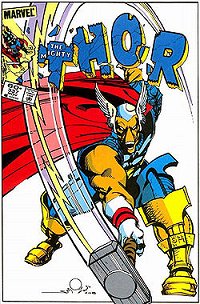
A mysterious galaxy-sized figure grabs the ingot and begins hammering out a
sword, sending out a peal of "DOOM!" that reverberates throughout the galaxy.
That's Simonson's run in a nutshell. Science fiction merges with myth and never,
ever does he settle for straight superhero fare. No one else could have pulled off
the moment where Skurge the Executioner, bereft of his magical axe, takes on the
hordes of Hel with M-16s. Or the moment in which a horse-faced alien grabs
Thor's hammer and transforms into the now infamous Beta Ray Bill.
And no one, not even Thor luminaries like J. Michael Straczynski and Michael
Avon Oeming, could ever have pulled off the story where Loki transforms Thor
into a frog, and the God of Thunder has a Watership Down-ish adventure with
frogs, rats, and crocodiles in the sewers. And then he gets his hammer back and
turns into a man-sized frog in Thor clothes, then proceeds to beat the croaky out of
Loki.
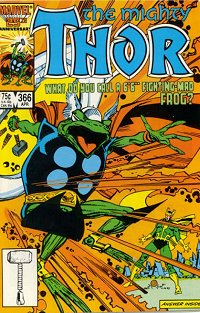
I love Thor. And the frog story is my favorite Thor story of all time.
I don't want to try and summarize every plotline Simonson throws out, but in
addition to the previously mentioned frog, Beta Ray Bill and journey through Hel,
there is a battle with Faerie and the Cask of Ancient Winters and the epic-sized
showdown with Surtur the Fire Demon, which lasts over a long span of issues
appropriately titled "Ragnarok n' Roll."
"Ragnarok n' Roll" is the best Thor comic story of all time. That's not a
controversial statement. Anyone who's read it will agree with me. Simonson's
herky-jerky, big and powerful art is at its best when Surtur cracks the Rainbow
Bridge with his immense Twilight Sword and strides through Asgard, a Norse
Godzilla, crushing houses and halls in his wake.
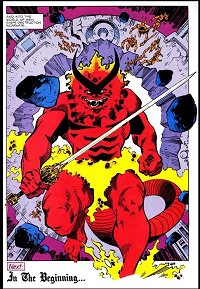
Simonson has the same gift as Frank Miller and John Romita Jr for marrying
symmetry with a quirky, off-kilter style. Part of the beauty of his artwork is seeing
how the Asgardian landscapes and hordes and immense monsters stretch to perfect
infinity, or the subtle interplay of Norse scrollwork within Loki's magic. He's got
the big-as-life dynamism down.
But part of the beauty is also seeing the half-finished, squiggly expressions of frogs
and rats and fire demons and the furiously flapping shadow of Hela's cloak as she
rakes her nails across Thor's face. A nice layer of messiness overlays the rock-solidity.
There is no way for a human being with feelings to not enjoy this comic. If you
don't like it, you are a Frost Giant and I feel sorry for your sad existence.
Speaking of feelings . . .
JLA/Avengers can be summed up in one delicious cognate word: geekgasm.
Perhaps we should add: geekgasm that might lead to a fatal heart attack.
You only have two choices when it comes to this comic: you either read Marvel
and DC for twenty plus years and get a good number of the references, or you
don't read Marvel and DC for twenty years and don't understand a word of it.
Here's a test: Darkseid holds the Infinity Gauntlet! The JLA versus Fin Fang
Foom! Marvel as Earth-2? Captain America and Superman bickering at a luau!
If you're drooling, then this is the comic for you.
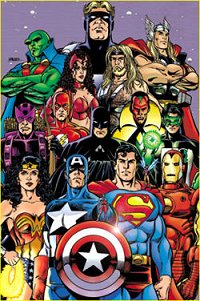
A Justice League versus Avengers story has been in the works since waaaaay back
in 1979. DC and Marvel, being rivals, couldn't come to an agreement despite the
fact that artist George Perez was well into drawing the project when it was
kiboshed.
Thank the Geek Gods that Perez was still willing to take on the project when DC
and Marvel hashed out an agreement in 2002, especially since Perez is the only
person who could ever live up to the amount of comics geekery that writer Kurt
Busiek squashed into this story.
Perez crowds the entire roster of the JLA and the Avengers into one two-page
spread here, and draws nearly every member in every incarnation somewhere else.
Despite all that, his drawings still communicate power and detail, and are still fun.
He's a real master of facial expressions, for all that his art is famous for its
hyperdetailed style.
The detail defeats Perez at times; this comic has so many characters and so much
happening that at times it looks like the Bayeux Tapestry.
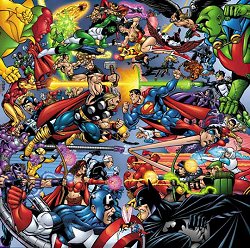
But it is a blast. A couple of meddling interdimensional gamesters send the JLA
and the Avengers off on two respective wild goose chases after various Marvel and
DC MacGuffins, including the Green Lantern's lantern, the Infinity Gauntlet, and
Simonson's own Cask of Ancient Winters. The JLA and Avengers fight each other
across every corner of the Marvel and DC universe, and in one memorable aside
that sadly takes place offscreen, Batman beats the snot out of the Punisher and
takes his guns.
Busiek also finds a great character conceit for the story: the JLA, particularly
Superman, are off-put by the harshness of the Marvel world. The Flash breaks the
interdimensional barrier and finds a quiet town railing against their newly
discovered "mutie freak." Superman angrily declares that these guys can't be
heroes, because they can't take care of their own citizens.
In contrast, Captain America sees the adoration of the JLA in the DC universe as
the embodiment of Nazism and sees Superman as his namesake the Ubermensch.
But ultimately this comic fails.
It drops the ball. Jumps the shark. Poops out.
Because . . .
Well.
I can hardly say it.
Despite all reason and logic being against such a travesty . . .
Superman beats Thor.
Even if I weren't rooting for Blondie, it would still be one of the worst, tiniest,
thinnest and surely most anticlimactic fights in the history of comicdom. Superman
and Thor should have had a good twenty pages of full-bore splash page fighting.
Instead, they hit each other. Thor slams his hammer down but Superman catches it,
and with a Spinal Tap reference -- a SPINAL TAP reference? -- tells Thor that
"On my world the dials go up to eleven!" Then he knocks Thor out and says "May
be the toughest foe I ever . . ."
BULL.
CRAP.
First of all, Superman is vulnerable to magic, because it can mess with the power
he absorbs from the sun. So when he gets hit with a freaking magic hammer, it
should break every one of his blue ribs, and his red-underwear clad pelvis.
So if we say that Norse magic doesn't affect him for whatever stupid reason, Thor
should have been smart enough to summon a windstorm and make Superman fly
after him. He should have blocked out the sun with some clouds to weaken Supes.
Okay, so Thor would rather leap bare-fisted into a fight than dance around with the
winds. I can respect that.
But he would still beat Superman. Superman is an alien who gets energized by the
sun. He's a glorified solar battery.
Thor is a GOD.
Nuff said, damn it.
Gods of Asgard is one of many comics that fills a particular niche: a not-so-hallowed adaptation of a hallowed work.
In this case it's the Poetic Eddas, but there are numerous other comics out there
that adapt classical works like Pride Prejudice or Shakespeare or Beowulf.
Here's the thing with them comics. Middle-school teachers are going to buy them
no matter whether they are good or bad. Marvel and other big companies will
produce them, but they are crapshoots. Artists might end up adapting a historical
work without the time to truly research the period, or create a unique style that can
capture the work.
This is an especially dangerous labor when it comes to something as awesome as
Norse myth.
But. Said comics could be a labor of love, based in the artist/writer's true
dedication to this work. I'm happy to say that Erik Evensen's work is the second.
The art and dynamic is comic-style all the way. Odin has some distressed dred-looking locks hanging over his eye in a fashion that manages to almost look emo
while still looking badassedly Norse. Thor is nice and squat and V-shaped, while
the ladies Freyja and Sif are tall blonde bombshells.
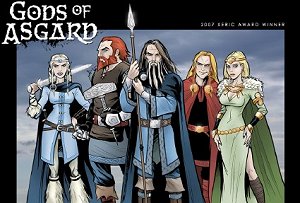
Loki is the star of the show, with his rock-star locks and clever sidelong looks at
the reader, showing wit none of the other gods possess. It only gets better as he
acquires the characteristic scars from getting his lips sewn together. In the end he
storms drunkenly into the hall of the Aesir and starts insulting everyone, bringing
forth the full brunt of his long-withheld anger. As always with Loki, I one-part
despised him and one-part sympathized with the poor trickster, who uses his brain
when everyone else can punch their way out of trouble.
This is the real Thor and Loki, by the way. Thor is much stupider than Simonson's,
and Loki cleverer. There is no simple good-guy bad-guy dichotomy here.
Evensen tells the myths straightforwardly, not trying to fill out anything that isn't
in the original Eddas. So when Frey kidnaps the giantess Gerd to be his love-slave,
Evensen doesn't clean up the rather disturbing implications, other than a cursory
"love can melt even the most frozen heart."
Nor does he hide Freyja's eyebrow-raising night with three dwarves in exchange
for a pretty necklace. Which will probably make this all the more entertaining to a
middle-schooler.
My Nordic-descended wife would like to add that Viking chicks are hot. In case
you didn't have enough reasons to love Thor.
'Tis the end of my tale, till we behold the glory of Thor in full-screen. Hearken, ye
people, and get thy patooties a theater on May 6 to behold the splendor of Thor. Sir
Branagh shall ne'er fail us.
Continued Below Advertisement
Read more by Spencer Ellsworth